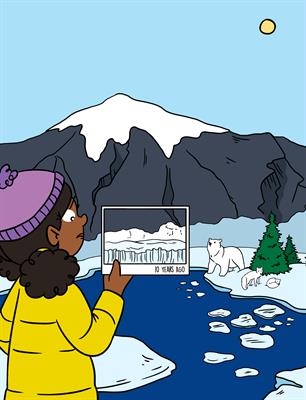
Changing Arctic Ocean
Collection Editors
Roxana Suehring, Penelope Lindeque, Kirsty Crocket, Christian MärzViews
464,695 viewsParticipating Sections
Submission Deadline
Closed
Articles

Earth Sciences
18/02/2021
Tiny But Powerful: How Tiny Amounts of Certain...
Authors
Hanna Campen, Hermann W. Bange
Earth Sciences
20/01/2021
The Movement of CO2 Through the Frozen World of...
Authors
Odile Crabeck, Karley Campbell, Sebastien Moreau, Max Thomas
Earth Sciences
26/11/2020
Freezing in the Sun
Authors
Giulia Castellani, Gaelle Veyssiere, Frank Kauker, Michael...
Earth Sciences
28/10/2020
The Future of the Arctic: What Does It Mean for...
Authors
Hanna M. Kauko, Mar Fernández-Méndez, Amelie Meyer, Anja...
Earth Sciences
28/09/2020
Virtual Reality: Using Computer Models to Learn...
Authors
James Ward, Felipe S. Freitas, Katharine Hendry, Sandra...
Earth Sciences
17/09/2020
The Bottom of the Arctic’s Food Web Is of Top...
Authors
Alexander G. Hayward, Jordan Jack Grigor
Earth Sciences
16/09/2020
The Arctic: An Upside-Down Ocean
Authors
Yueng Djern Lenn, Benjamin Lincoln, Markus Janout
Earth Sciences
09/09/2020
Life Inside and Under Frozen Seawater
Authors
David N. Thomas, Hermanni Kaartokallio
Earth Sciences
31/08/2020
How Melting Arctic Sea Ice Can Lead to Starving...
Authors
Doreen Kohlbach, Benjamin A. Lange
Earth Sciences
14/08/2020
How Is Climate Change Affecting Marine Life in...
Authors
Michael R. Heath, Deborah Benkort, Andrew S. Brierley, Ute...
Earth Sciences
24/07/2020
How Nutritious Will the Future Arctic Ocean Be?
Authors
Pearse J. Buchanan, Robyn E. Tuerena, Alessandro Tagliabue...
Earth Sciences
15/07/2020
The Polar Sea Ice Melts: What Happens to the Fish...
Authors
Leif Christian Stige
Earth Sciences
15/07/2020
Reduce, Reuse, Recycle in the Arctic Ocean With...
Authors
Birthe Zäncker, Rowena F. Stern, Elliott L. Price, Michael...
Earth Sciences
22/05/2020
How Do We Track Changing Arctic Sea Ice?
Authors
Olivia Lee
Earth Sciences
30/04/2020
DVM: The World’s Biggest Game of Hide-and-Seek
Authors
Jennifer J. Freer, Laura Hobbs
Earth Sciences
26/02/2020
Marine Copepods, The Wildebeest of the Ocean
Authors
Daniel J. Mayor, Kathryn B. Cook, Thomas R. Anderson, Anna...
Earth Sciences
05/02/2020
A Long Way From Home—Industrial Chemicals in the...
Authors
Roxana Sühring, Miriam L. Diamond, Martin Scheringer, Liisa...
Earth Sciences
04/02/2020
What Is Blue Carbon and Why Is It Important?
Authors
David K. A. Barnes
Earth Sciences
03/12/2019
The Carbon Story of a Melting Arctic
Authors
Johan C. Faust, Christian März, Sian F. HenleyAbout this collection
The Arctic is the most northern part of our Earth. It is a huge area that spans over several countries including; Canada, Denmark (Greenland), Finland, Iceland, Norway, Sweden, Russia, and the USA. However, the largest part of the Arctic is not on land but is covered by water – the Arctic Ocean.For hundreds of thousands of years, large parts of the Arctic Ocean were covered by ice all year around. Many animals, such as polar bears, Arctic foxes, seals, fish and birds, and even some people have made this icy place their home. They have learned to live with the ice, and some animals even need it to live.
But recently, things in the Arctic have been changing. You have probably already heard a lot about Climate Change. Climate Change impacts the long-term weather (climate) everywhere on our planet. Many areas get warmer, some get colder, and everywhere we see more extreme or unusual weather, such as storms, floods or droughts. But nowhere is Climate Change happening as fast as in the Arctic.
You might have also heard about the “2°C goal”. This is a goal that many governments around the world have agreed to. The plan is essentially to make sure the average global warming of our atmosphere stays at less than 2°C compared to what people like to call “pre-industrial time” (the year 1948 is used as a reference).
Right now, most of the world is at around 0.8°C warming. In the Arctic, we are already at 2.3°C warming – that is 0.3°C above what should be the absolute maximum according to the “2°C goal”.
Now you probably ask why it is so bad that the Arctic is getting a bit warmer. That should make it a nicer place to live, right? Unfortunately, the warm temperature means that the ice that has covered the Arctic Ocean for all this time is melting. It looks like that will change the Arctic Ocean forever and with it the animals and people that call the Arctic their home.
In this collection, we want to tell you what we, as scientists, know about the changes in the Arctic; how we investigate these changes and what we have learned from our travels to the Arctic and the analyses we do in our research institutes. We will tell you about how the higher temperatures in the Arctic change the ice. How very tiny animals can have a huge impact. We want to introduce you to life in the ice, under the ice, and at the seafloor. We will talk about processes that make the Arctic Ocean so special and chemicals that can travel from our homes and cities all the way to the Arctic.
Would you like to submit to this collection?
For researchers interested in submitting to this Collection, please consult our author guidelines and check that you have all the essentials included before submitting






















